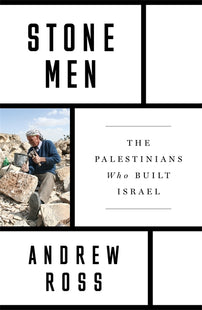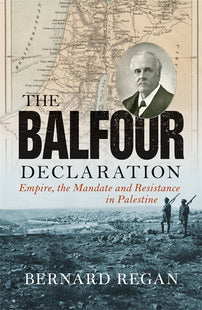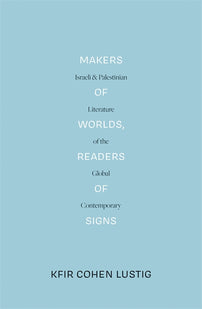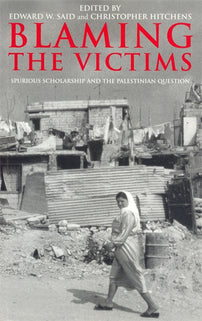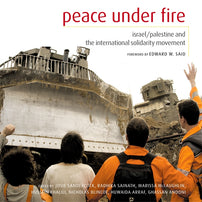New and Old Facts
Ross’s engrossing, surprising, and gracefully written story shows how the stones of historic Palestine, and Palestinian labor, have been used to build the state of Israel—in the process, constructing “facts on the ground”—even while the industry is central to Palestinians’ own efforts to erect bulwarks against the Occupation.

In Stone Men: The Palestinians Who Built Israel by Andrew Ross, the paradoxes of Israel's ongoing settler-colonial project are interrogated and exposed through the lens of Palestinian stoneworkers. The laborers, sometimes working informally or illegally, experienced or are descendants of those who experienced the various Nakbas where homes and entire villages were destroyed or whose occupants were simply replaced by settlers. Now, they must build the structures that replace and obscure their own. In this excerpt, however, Ross speaks to those Palestinians engaged in subvervise stonework for the preservation and reproduction of Palestinian history, culture and liberation.
****
In the winter and spring of 2017, I set out to meet some of the workers who had been employed on the Tashgheel and 50 Villages projects. My visits took me to sites in the central highlands of the West Bank—to regions east of Jerusalem and north of Ramallah—where the landscape of hilltop villages comes closest to matching the picture- book iconography of the Holy Land. The hills are well-rounded, and limestone outcroppings are exposed at every elevation; dry stone walls and mule paths wind around their contours, protecting the ter- races where olive and fruit trees used to grow in greater abundance than they now do. These walls and terraces, and the landed economy they still keep in place, are hundreds, if not thousands, of years old, but their chief (agricultural) purpose has been gradually sidelined over the last half-century. Some of the highest hilltops overlooking the villages are occupied by strategically placed Israeli settlements, their uniform red-tile roofs and defensive architectural orientation declaring their alien, quasi-military presence on the land.10
In their old family home in Jaba village, just to the north of Jeru- salem and east of the mammoth Qalandia quarry, I sat down with two brothers who had worked on Riwaq projects for three and a half years. Formerly employed in a cake factory at a meager 30 shekels a day, and with no prior construction experience, they had been hired by a Riwaq project contractor on a 90 shekel per day rate (eventually earning 120). After learning many skills on the job from a master mason, Mohammed (the elder brother) noticed a change in his social status in the village. “When people saw me consulting with the architect or engineer, I was seen as someone important.” Looking around at the family home he had helped to rebuild, Mohammed drew attention to the craftwork that sealed the stones in the walls, and the dark grout (kuhla) used for pointing. Underneath was a tra- ditional lime-based (sid ) mortar that had seen centuries of usage by Palestinians—the stone facing itself was from Birzeit, to the north, famous for its gray colors. “My children and grandchildren,” he said proudly, “will know who did this and why.”
Nor did he think his restoration labor was merely a family matter. “When I work on this,” he asserted, knocking on the walls of his home, “I am working for my people, for Palestine. Sure, I could earn more money in Israel, but you are working for the oppressor there.” His brother chimed in, as if to soften any suggestion of militancy: “We don’t throw stones, we build with them.” Geva Binyamin, the nearest Israeli settlement, was visible just across the highway, and given how fast “Greater Jerusalem” was expanding its suburban orbit in their direction, it was easy to see how vulnerable Jaba could be. The Riwaq project to reconnect community ties between the old center and the more recently built part of the village was supposed to firm up the lines of defense, in anticipation of worst-case eviction scenarios.
Even more precarious was the village of Beit Iksa, sitting just outside the boundary line of the Jerusalem municipality. The Israeli authorities had already seized most of the town’s agricultural land in the 1970s to build the surrounding settlements of Ramot and Har Shmuel, and, more recently, for a high-speed train line to Tel Aviv. Even more acreage is under threat from an impending confiscation order by the military authorities. These steady encroachments are in keeping with Israel’s policy of expropriating land but not people, in order to preserve the demographic balance favoring the Jewish majority. Of its pre-1948 property of 16,000 dunums, a mere 680 remain in Beit Iksa hands. Portions of the Separation Wall now encircle the village and its 1,600 inhabitants, and a military check- point straddles the only entrance. All the visible evidence suggests that Beit Iksa has been earmarked for incorporation into Jerusalem. Ahmed, a painter and draughtsman formerly employed by Riwaq, told me that the checkpoint was intended to prevent nearby villagers from establishing residence in hopes of securing one of Jerusalem’s much sought-after blue identity cards. “Some people made up rental contracts, and others fabricated village IDs to stake a claim.”
Beit Iksa also seems to offer easy access across the Green Line. “You can see why,” Ahmed pointed out, gesturing to the valley below the southern edge of the village, “walk from here and you will be on Jaffa Road [in Jerusalem] in twenty minutes.” Such a journey would take more than two hours to go by car, through sec- ondary roads now lined with concrete, military walls topped with razor wire, and then through Ramallah and the heavily congested Qalandia checkpoint. Those who risk the twenty minute (illegal) journey by foot through the valley below would have to pass by the foreboding sites of two former Palestinian villages, Lifta and Deir Yassin.
Lifta is the only pre-1948 Palestinian village in Israel that was cleansed of people but not razed or repopulated by Jews, and it is a rich heritage site, with buildings dating to Hellenic and Roman eras. A joint Israeli–Palestinian coalition recently sprang up to save the village from being redeveloped for luxury housing. Little remains of Deir Yassin, a former town known worldwide for the 1948 massa- cre (and rumored rape) of as many as two hundred residents by the Irgun and Lehi paramilitaries. Before it was decimated, Deir Yassin had been famous for its quarry and stonemasons and for a variant of mizzi yahudi (Jewish stone) limestone named for the town itself (hajjar yassini). The quarry, which had sustained so many liveli- hoods, became a dumping ground for the massacre victims.
News about the Deir Yassin massacre travelled all across Pales- tine, prompting mass flight. A Beit Iksa village councilor told me that “most of our residents fled to the east, across the River Jordan, and today as many as 37,000 of our refugees have been identified in Jordan.” He also recounted how the village center was almost destroyed during the Haganah occupation from 1948 to 1953, after which it was exchanged for another village south of Jerusalem in a deal with the Jordanians (“but we only got half our land back”). The 1967 invasion saw additional damage and another wave of evictions. Most of the refugees, he admitted, especially the ones with money and education, had stayed on in Jordan because of the better oppor- tunities there. The family of Ahmed the painter was one of those who never left, and he continued to reside in the ancestral home until it began to crumble. Earnings from working stints in Jordan and in the nearby Ramot settlement eventually allowed him to build a new home further down the hill, but when Riwaq offered him a job, the convenience of working in his own village was sufficiently appealing, even though the wages (90 to 100 shekels per day) were less satisfactory to him.
On a return visit to the village a few months later, I interviewed Abdu, a contractor—and veteran of more than ten Riwaq projects— and one of his crew. Both confirmed that the compensation for the restoration work was lower than the going rate for conventional construction jobs. Abdu took on both kinds of work, but he pre- ferred the restoration, even though it was more dangerous (falling walls, snakebites, unexploded bombs), more onerous (lifting stones that weighed 180 kilos), and more of a technical challenge by far. Because of his expertise, he said that Israelis had approached him, offering to double his salary to work on old Jerusalem buildings. Not only had he refused, but he was also vigilant about fending off the not infrequent efforts of settlers to steal old stones and tiles from Riwaq project sites. “This kind of restoration is important if only to protect the stones lying around on the ground from being carted off,” he insisted, recalling his role in one such operation: “they came to al-Tayba during the night, with a large truck, to try to steal an entire well, but we were alerted and rushed there and managed to save it.” Ibrahim, his crew worker, also spoke of the value, to himself and to Palestinians, of protecting the stones. He had an Israeli work permit and had worked in Tel Aviv and Beit Shemesh in the past, but preferred the Riwaq projects, even though they paid less. “Going inside ’48 is too humiliating for me,” he insisted, “and I discovered that this is what I really want to do.”

